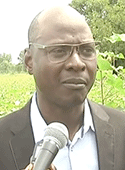Keynote Speaker
Mamy Soumaré, University of Social Sciences and Management of Bamako, Mali

Mamy Soumaré is a geographer, lecturer at the University of Social Sciences and Management of Bamako and associate researcher at the Institute of Rural Economy in Mali. His research focuses on the dynamics and sustainability of farmers and their territories mainly in the cotton zones in West Africa. He is the author of several publications and contributor to numerous collective works on the constraints of farming systems in these areas despite significant transformation and important agricultural production.
Talk title: Agricultural production and food and nutrition security in west African cotton zone: the “paradox”
Abstract
Agriculture in Malian cotton belt has undergone a major change during the last fifty years under the cotton influence. This transformation, described as an « agricultural revolution» or a «success story», has contributed to increased agricultural production and producer incomes. However, it is questionable whether this transformation is beneficial for food security and farmers and their family's well-being. What are the food insecurity manifestations in the cotton zone? How do we explain malnutrition despite significant and diversified agricultural production and appreciable livelihoods? What lessons do we draw from this paradox for research, policy makers and developers? Based on literature reviews and practical experiences, this current presentation shows that agriculture in the cotton zone earned a rare success in Africa in terms of development during the first decades of independence. It shows the following observations that emerge from the «Paradox of Sikasso»: 1) the malnutrition mentioned concerns mainly children, 2) it is more related on how food is utilized than its availability or access, 3) cultural habits can negatively impact food security through consumption patterns, 4) data quality and methods of interpretation are discussion subject, and 5) much progress has been accomplished in food and nutrition security, and researchers and decision-makers must move towards new challenges.
« Go Back